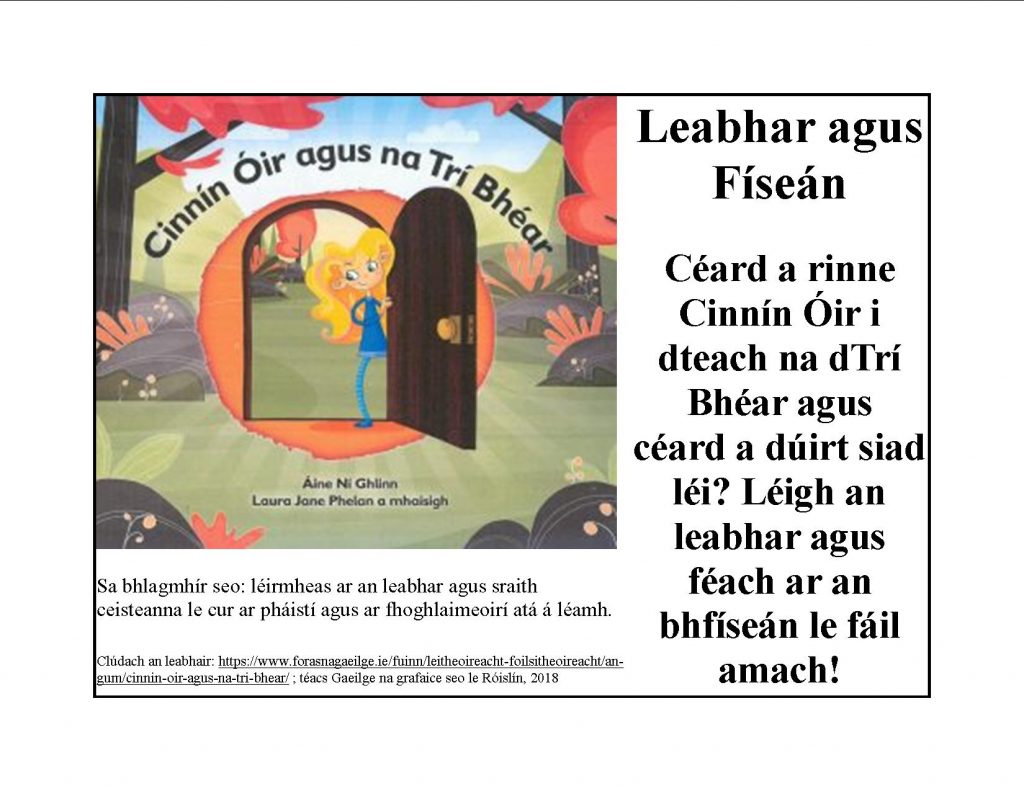Review: A charming retelling of Goldilocks in Irish with animated video (Cinnín Óir agus na Trí Bhéar) Posted by róislín on Sep 30, 2018 in Irish Language
(le Róislín)
A charming retelling of a classic tale, with an animated video, to boot.
While I have enjoyed many Irish videos, animations, and cartoons, going back at least as far as “Bouli” (early 1990s), many of them have very rapid-paced dialogue and sometimes I’m a bit reluctant to recommend them to elementary learners because the speakers can be difficult to understand. Of course, the mission of such cartoons is not to be educational as such, but to provide entertainment. Similarly, I probably wouldn’t recommend that ESL learners start with Bugs Bunny or Groucho Marx, although it’s always a good goal to strive for enjoying humor in the target language one is studying.
But the 2017 book and video of Cinnín Óir agus na Trí Bhéar (ISBN 9781857919356) is a sheer delight for children, adult learners at the elementary level, or anyone who enjoys reading picture books. The story is retold by Áine Ní Ghlinn. The pictures by Laura Jane Phelan are lively and the text has a bouncy rhyme scheme, perhaps not poetry as such but with catchy pairs of sounds like “dul a luí” and “a haon, a dó, a trí,” or “Cinnín Óir” and “go leor.”
There’s also some great pronunciation practice, with the alternating broad and slender b sounds (b leathan agus b caol). In particular the combinations “beag bídeach” and “beag buí” occur numerous times. Both “beag” and “bídeach” have a slender “b” sound, and “buí” has a very broad “b” sound, like “bwee.”
There’s also practice with séimhiú (lenition) and urú (eclipsis). The phrase “beag bídeach” also shows up as “bheag bhídeach” (with séimhiú) after “leaba” and “cathaoir.” Why? Because “leaba” and “cathaoir” are grammatically feminine, which triggers the change. We also see some alternation between “cathaoir,” “chathaoir,” and “gcathaoir,” with the phrases “an chathaoir mhór” (with séimhiú) and “ar an gcathaoir” (with urú). It may not have been the author’s original intention, but it’s good reinforcement for this tricky aspect of Irish spelling and pronunciation.
There are two nice examples of “uaillbhreasa” in the text, one perhaps international, at least well known in English (“Grrrr!” for the bears growling), but also a second one that might surprise “lucht labhartha an Bhéarla” (“Neam, neam, neam!” which means “Yum, yum, yum!”). Given that the “n” is slender, the phrase actually sounds a lot like “nyum, nyum, nyum.” Certainly a useful phrase for anyone raising their children in Irish.
But from the perspective of the young child enjoying this book, it’s not a matter of séimhiú and urú, or vocabulary, or sentence structure. It’s a fun text with just the right amount of repetition to tickle a young child’s fancy. The counting bits (a haon, a dó, a trí) work almost like a refrain in a song, and no doubt children will chime in and read along with their parents at that point.
The voice of the narrator (Bríd Ní Neachtain) is crystal clear and the pacing is perfect. She also modulates nicely between the higher pitched child’s voice and a deeper but appealing narratorial tone.
All in all, I would recommend this book, and the video that An Gúm has posted (YouTube, Vimeo) very highly for families with young children and for learners.
For teachers, I’ve added a short list of questions and exercises here that might make the book even more beneficial for classroom use.
1.. Cá bhfuil na trí bhéar ina gcónaí?
a) in uaimh b) i bpluais c) i dteach beag gleoite i gcoill
Another way to ask this question, for slightly more advanced vocabulary, is “Cá bhfuil na trí bhéar ag cur fúthu?”
2.. Cén dath atá ar an mbéirín beag?
a) donn b) dubh c) buí
3.. Céard atá sna babhlaí sa chistin?
a) anraith b) leite c) calóga arbhair
And for a little vocabulary stretch: d) maistreán
4.. Céard a deir Cinnín Óir nuair atá a bolg lán?
a) Hé presto! b) A thiarcais! c) Neam, neam, neam!
5.. Céard a chuala Cinnín Óir nuair a bhí sí ag rith ó na trí bhéar?
a) Chuala sí na béir ag canadh. b) Chuala sí na béir ag feadaíl. c) Chuala sí na béir ag dorraíl.
Another exercise would be to rephrase the text in the present tense, which would involve changing the endings of the past-tense verbs and making some adjustments for irregulars. The past tense forms are: bhí, bhris, chonaic, chuaigh, chuala, d’ith, d’oscail, léim, luigh, rinne, rith, shuigh, tháinig, tharla, thit (Freagraí, na foirmeacha san aimsir láithreach, thíos)
So, sin é moladh ard don athinsint seo ar scéal a bhfuil seantaithí againn air. Tá súil agam go mbainfidh tú sult as an leabhar agus as an bhfíseán atá ar YouTube agus ar Vimeo. – SGF – Róislín
P.S. Tá léirmheas suimiúil eile le Pól Ó Muirí ar fáil ag https://www.irishtimes.com/culture/treibh/an-damh%c3%a1n-alla-agus-cinn%c3%adn-%c3%b3ir-1.3198056 “An damhán alla agus Cinnín Óir: Dhá leabhar nua don tseomra ranga – agus don duine fásta” Mon, Aug 28, 2017
Freagraí: 1.. c, 2. c, 3. b, 4. c, 5. c. Briathra san aimsir láithreach: tá, briseann, feiceann, téann, cloiseann, itheann, osclaíonn, léimeann, luíonn, déanann, ritheann, suíonn, tagann, tarlaíonn, titeann.
Naisc YouTube agus Vimeo: https://www.youtube.com/watch?v=91Aa8lBXUos agus https://vimeo.com/214672971
According to the publisher’s website https://www.forasnagaeilge.ie/fuinn/an-gum/ceannach/, the book can be purchased (list price €8.50) at the following sites:

Build vocabulary, practice pronunciation, and more with Transparent Language Online. Available anytime, anywhere, on any device.





Leave a comment: